Main page
Learn how to select and adjust Themes from the Main page in Action Woodwinds.
The Main page is the first page that opens when you start Action Woodwinds. On the Main page you can see the current Theme, adjust its basic settings, and select another Theme.
The Main page consists of the following elements and areas:
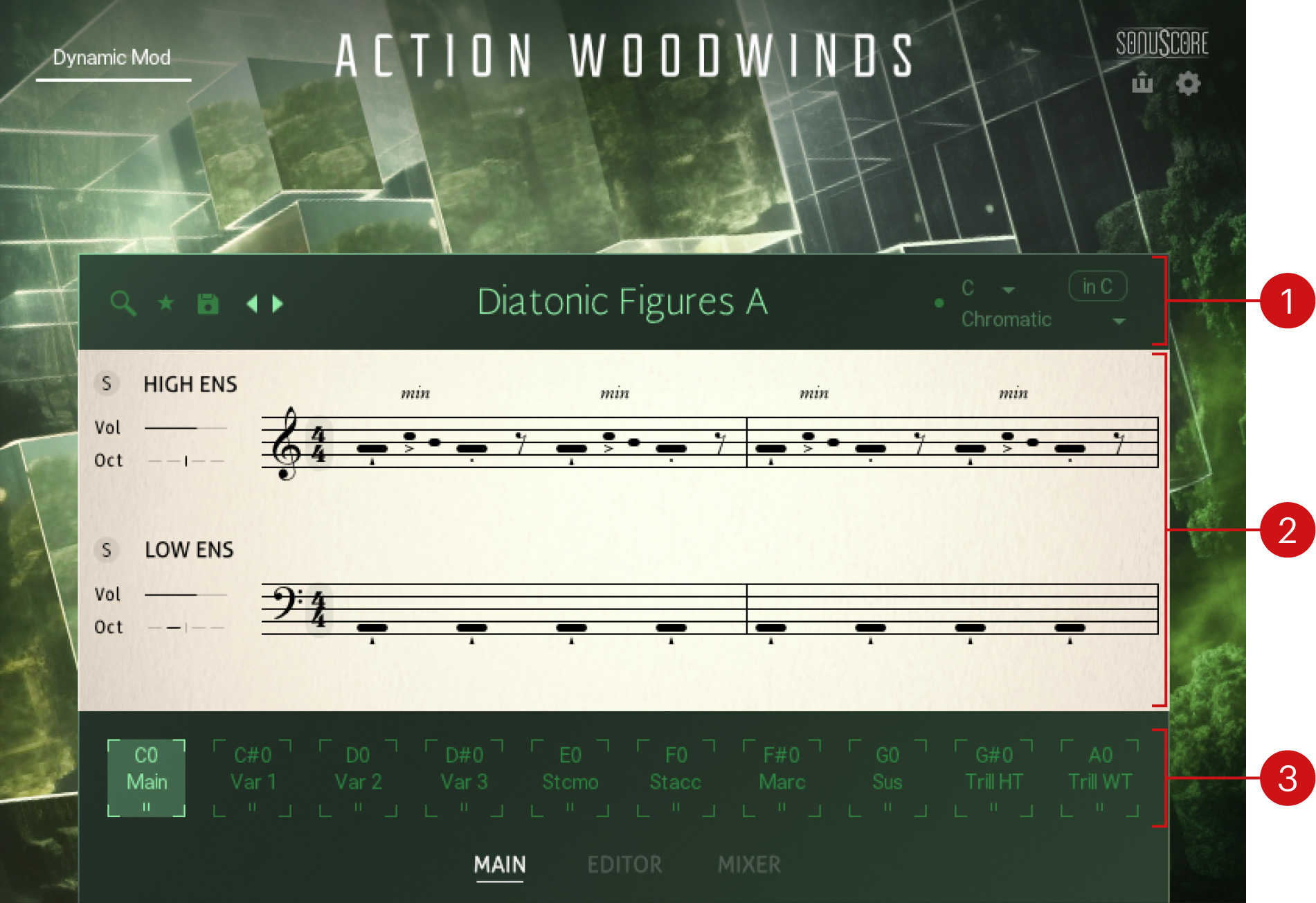
Theme header: Displays the current Theme, and lets you browse and load available Themes, set the current Theme as Favorite, and save your own Themes. The Theme header also includes the Scaler. For more information, refer to Theme header.
Phrase Slots: Display the Phrase played by each Ensemble on the selected keyswitch, and let you browse and load other Phrases and adjust basic settings for each Ensemble. For more information, refer to Phrase Slots.
Keyswitches: Indicate the active keyswitch and let you select another one, which will switch to another pair of Phrases included in the Theme. For more information, refer to Keyswitches.
Themes
A Theme is a set of 10 pairs of Phrases and Articulations for both Ensembles. Each pair includes one Phrase or Articulation for the High Ensemble, and one matching Phrase or Articulation for the Low Ensemble. Each pair is assigned to a different keyswitch, so that you can quickly switch between Phrases and Articulations within the loaded Theme.
Theme header
The Theme header shows the name of the current Theme. It lets you browse and load available Themes, set the current Theme as Favorite, save your own Themes, as well as control the Scaler for the current Theme.

Browse (magnifying glass icon): Opens the Theme Browser, where you can browse the available Themes for loading.
Favorite (star icon): Adds the current Theme to the Favorites (the star turns on), or remove it from the Favorites (the star turns off). You can then filter quickly within the Theme Browser to display only your favorite Themes.
Save (disk icon): Saves the current Theme as User Theme.
Previous/Next (<> icons): Quickly switch to the previous/next Theme in the Theme list without opening the Theme Browser.
Theme name: Displays the name of the current Theme. Clicking the Theme name opens the Theme Browser. This is equivalent to clicking the Browse button (magnifying glass) on the left.
Scaler: Activates and adjusts a scaling engine affecting all Phrases and Articulations in the current Theme.
Theme Browser
The Theme Browser contains filters to help you sort all Themes by different characteristics and quickly find and load the desired Theme.
To open the Theme Browser, click the Theme name at the top of the Main page, or click the little magnifying glass in the top left corner of the page.
The Theme Browser contains the following controls and areas:
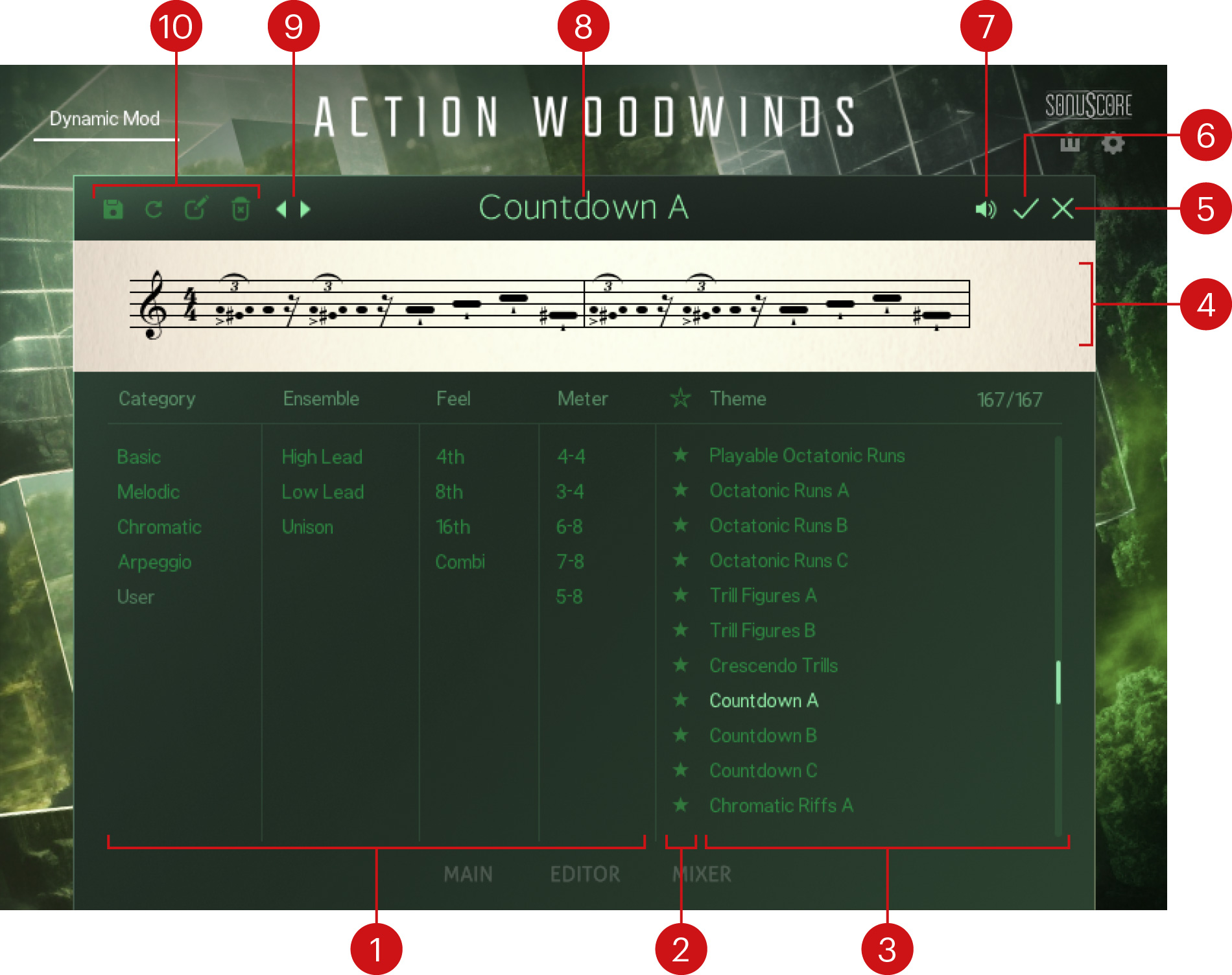
Tag filter: Displays the tags organized in four columns (Category, Ensemble, Feel, Meter). You can select only one tag in each column simultaneously. For more information, refer to Theme Browser tags.
Favorites: You can click the star icons to add or remove Themes to/from your Favorites. The star icons are lit for Themes set as Favorites. This way, you can quickly create a custom collection of your most beloved Themes. You can then display only your favorite Themes by clicking the topmost star icon next to the Theme list header. Click the topmost star icon again to display also non-favorite Themes.
Theme list: Shows the Themes matching the tags selected in the Tag filter on the left. You can click a Theme to load it and try it directly on your keyboard or in your DAW. You can double-click a Theme to load it and close the Browser.
Phrase display: Represents the main Phrase of the Theme selected in the Theme list, that is, the Phrase assigned to the first keyswitch C0 for the High Ensemble. The Phrase display can help you visually recognize particular Themes when switching between entries from the Theme list.
Cancel (cross icon): Closes the Theme Browser without changing anything. Your Kontakt Instrument returns to its previous state.
OK (check mark icon): Keeps the selected Theme loaded and closes the Theme Browser. This is the same as double-clicking the Theme in the Theme list.
Preview (loudspeaker icon): Switches the Preview function on or off. If Preview is on, when you click a Theme in the Theme list you can hear it in action.
Theme name: Displays the name of the Theme selected in the Theme list and temporarily loaded.
Previous/Next (<> icons): Quickly switch to the previous/next Theme in the Theme list.
User Theme tools: Provide controls for saving, importing, editing, and deleting User Themes. For more information, refer to User Themes.
Theme Browser tags
To simplify your search for Themes, the tags are organized into four columns. Only one tag in each column can be selected simultaneously.
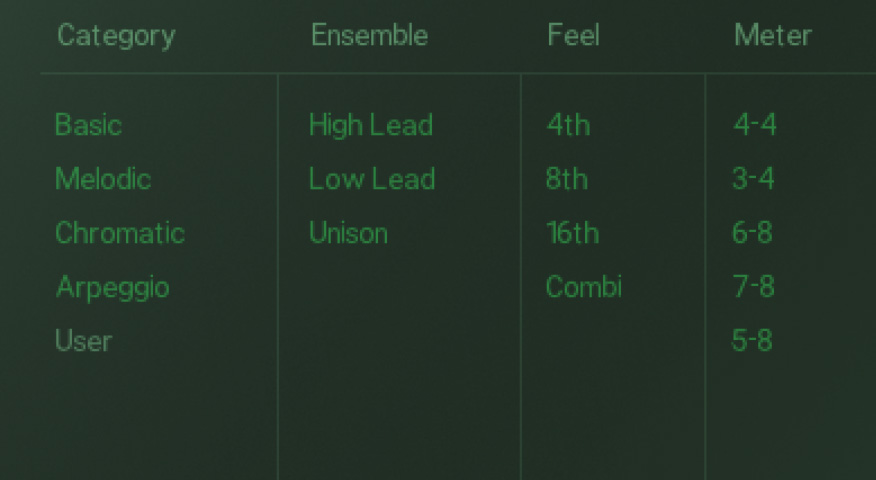 |
The tags in the Theme Browser
Category: In general, all Themes in Action Woodwinds are created with five main categories in mind, applicable in different compositional scenarios:
Basic: Single Pitch Phrases playing rhythmic patterns. Optimized for playing chords.
Melodic: Melodic Phrases with a tonal center. Optimized for generating melodies out of a single note.
Chromatic: Melodic Phrases with less strict tonality. Can be used for playing both single notes and chords.
Arpeggio: Themes based on an arpeggiator. Optimized for playing chords.
User: Reserved for User Themes.
Ensemble: Filters the Themes according to their Ensemble emphasis:
High Lead: The focus in the arrangement is on the High Ensemble.
Low Lead: The focus in the arrangement is on the Low Ensemble.
Unison: Both Ensembles play the same melody.
Feel: Allows for searching Themes with a quarter, eighth, or sixteenth note focus.
Meter: Filters the Themes according to their time signature.
User Themes
User Themes are custom Themes that you or other users have created. Each User Theme is accessible as a single file, making it easy to transfer and share between multiple systems.
You can save User Themes both from the Theme header of the Main page and from the Theme Browser. The Theme Browser also provides dedicated tools to organize your User Themes.
Note
In the Theme Browser, the User tag in the Category column is automatically assigned to all User Themes. You can select this tag to show only User Themes in the Theme list.
User Theme tools
To manage your User Themes, the Theme Browser provides the following tools:
 |
Save (disk icon): Saves the current state of the loaded Theme as a User Theme. For more information, refer to Saving a User Theme.
Scan (cycling arrow icon): Imports User Themes. For more information, refer to Importing User Themes.
Edit (pencil icon): Lets you rename your User Theme and modify its tags. For more information, refer to Editing a User Theme.
Delete (trash bin icon): Removes the User Theme from the Theme Browser.
Note
A User Theme that has been removed from the Theme Browser using the Delete button (trash bin icon) will not automatically reappear upon the next import using the Scan button (cycling arrow icon). To make it appear again in the Theme Browser, press [option] (Mac) / [Alt] (Windows) + click the Scan button.
Saving a User Theme
To save a User Theme:
Click the Save button (disk icon) in the Theme header of the Main page or in the User Theme tools of the Theme Browser.
Enter a new name.
If you are in the Theme Browser, you can immediately assign tags to your Theme in the Tag filter.
Click the check mark to save the User Theme, or click the cross to cancel the process.

When you click the check mark, the User Theme is saved and is available within the Theme Browser.
User Themes are saved as single .nka files into the User Data/Themes folder under the Action Woodwinds installation directory.
Note
The Action Woodwinds installation directory is located in the content folder defined in Native Access (Preferences panel > File Management page > Content Location field).
Editing a User Theme
You can modify the name and the tags of an existing User Theme as follows:
Open the Theme Browser.
Select the desired User Theme in the Theme list.
Click the Edit button (pencil icon) at the top left of the Theme Browser.
Modify the Theme name and/or select different tags in the Tag filter.
Click the check mark to save your changes, or click the cross to cancel the process.
Note
The tag in the Category column cannot be modified: The User tag is automatically assigned to all User Themes.
Importing User Themes
To import User Themes:
Close the Action Woodwinds instrument in Kontakt or Kontakt Player.
Copy the .nka files of your choice into the
User Data/Themesfolder under the Action Woodwinds installation directory.Note
The Action Woodwinds installation directory is located in the content folder defined in Native Access (Preferences panel > File Management page > Content Location field).
Open the Action Woodwinds in Kontakt or Kontakt Player.
Open the Theme Browser.
Press the Scan button (cycling arrow icon) in the top left corner.
The new User Themes are imported from the
User Datafolder.
Caution
Make sure to copy the .nka files in the User Data/Themes folder before you open the Action Woodwinds instrument, otherwise Kontakt may not recognize all files.
Caution
Do not delete the --START--.nka file from the User Data/Themes folder, otherwise your User Themes may not be properly recognized.
Scaler
The Scaler deactivates any key that is not in the specified scale. Additionally, it automatically exchanges Modules with equivalent Modules that fit into the specified scale, if available.
 |
On/Off switch (little dot): Activates or deactivates the Scaler.
Root Note menu: Selects the scale’s root note.
Scale Type menu: Selects the scale type.
in C button: Maps the selected scale onto the white keys of your keyboard with the root note on C.
When the Scaler is active, among the blue trigger keys, the on-screen keyboard in Kontakt and the Light Guide on your Kontrol keyboard show the root notes in violet, while inactive keys are off.

On the on-screen keyboard, the root notes are in violet and the inactive trigger keys are off: Scaler active, E minor scale selected, and in C off

The on-screen keyboard for the same E minor scale, now with in C turned on.
Phrases
A Phrase is a sequence of notes played by the High or Low Ensemble.
Phrase Slots
The Phrase Slots of the Main page represent the two active Phrases: the upper slot shows the Phrase for the High Ensemble, and the lower slot the Phrase for the Low Ensemble. The Phrases currently active depend on the selected keyswitch, which is indicated at the bottom of the page.
On each slot, the area left of the Phrase display provides global controls for the corresponding Ensemble.
Each Phrase Slot contains the following controls:
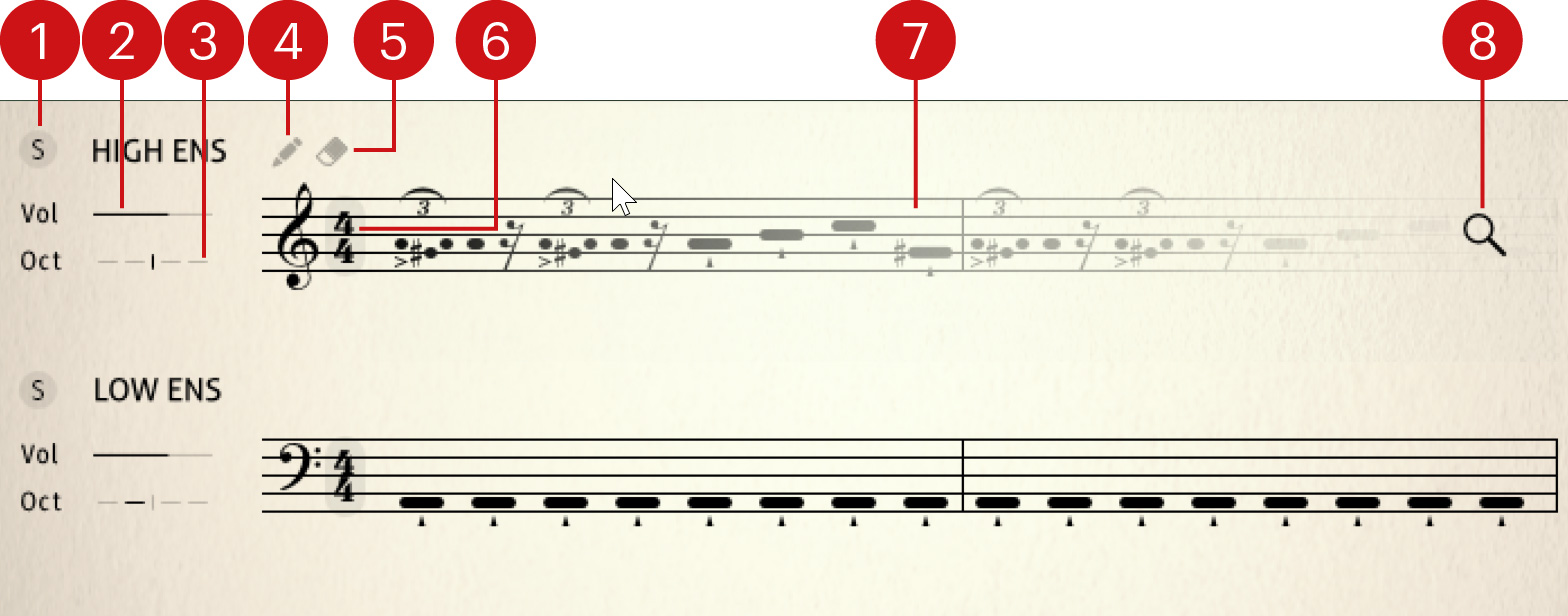
Solo (S icon): Lets you hear this Ensemble alone (it mutes the other Ensemble). This button is synchronized with its dedicated keyswitch A-1 or B-1 on your keyboard. This button is also available at the top of the Editor and Mixer pages.
Vol: Adjusts the volume of the Ensemble. Click + drag left to decrease the volume, and right to increase it.
Oct: Transposes the Ensemble by one or two octaves. Click + drag left to transpose downwards, and right to transpose upwards. At the middle position, the Ensemble is not transposed.
Edit (pencil icon): Opens the Phrase in the Phrase Notation of the Editor page, where you can customize the Phrase. The Edit button is only visible when hovering your mouse over the Phrase display.
Clear (eraser icon): Removes the Phrase from the Phrase Slot. The Clear button is only visible when hovering your mouse over the Phrase display.
Time signature: Shows the Phrase’s time signature. You can click the value to select another time signature for the Phrase.
Phrase display: Shows the Phrase content in a score-like representation. The Phrases are notated in treble and bass clefs for the High and Low Ensembles, respectively, and are always depicted using A as the root note. The actual sounding pitch will be based on whatever notes you play on your keyboard. The actual sounding pitch will be based on whatever notes you play on your keyboard. You can click anywhere in the Phrase to open the Phrase Browser and select another Phrase for that Ensemble. This is equivalent to clicking the Browse button (magnifying glass) that appears on the right.
Browse (magnifying glass icon): Opens the Phrase Browser to select another Phrase for that Ensemble. The Browse button is only visible when hovering your mouse over the Phrase display.
Phrase Browser
The Phrase Browser contains filters to help you sort all Phrases by different characteristics and quickly find and load the desired Phrase.
To open the Phrase Browser for an Ensemble, click anywhere in the Phrase display of its Phrase Slots on the Main page, or click the magnifying glass that appears on the right when hovering over the display.
The Phrase Browser contains the following controls and areas:
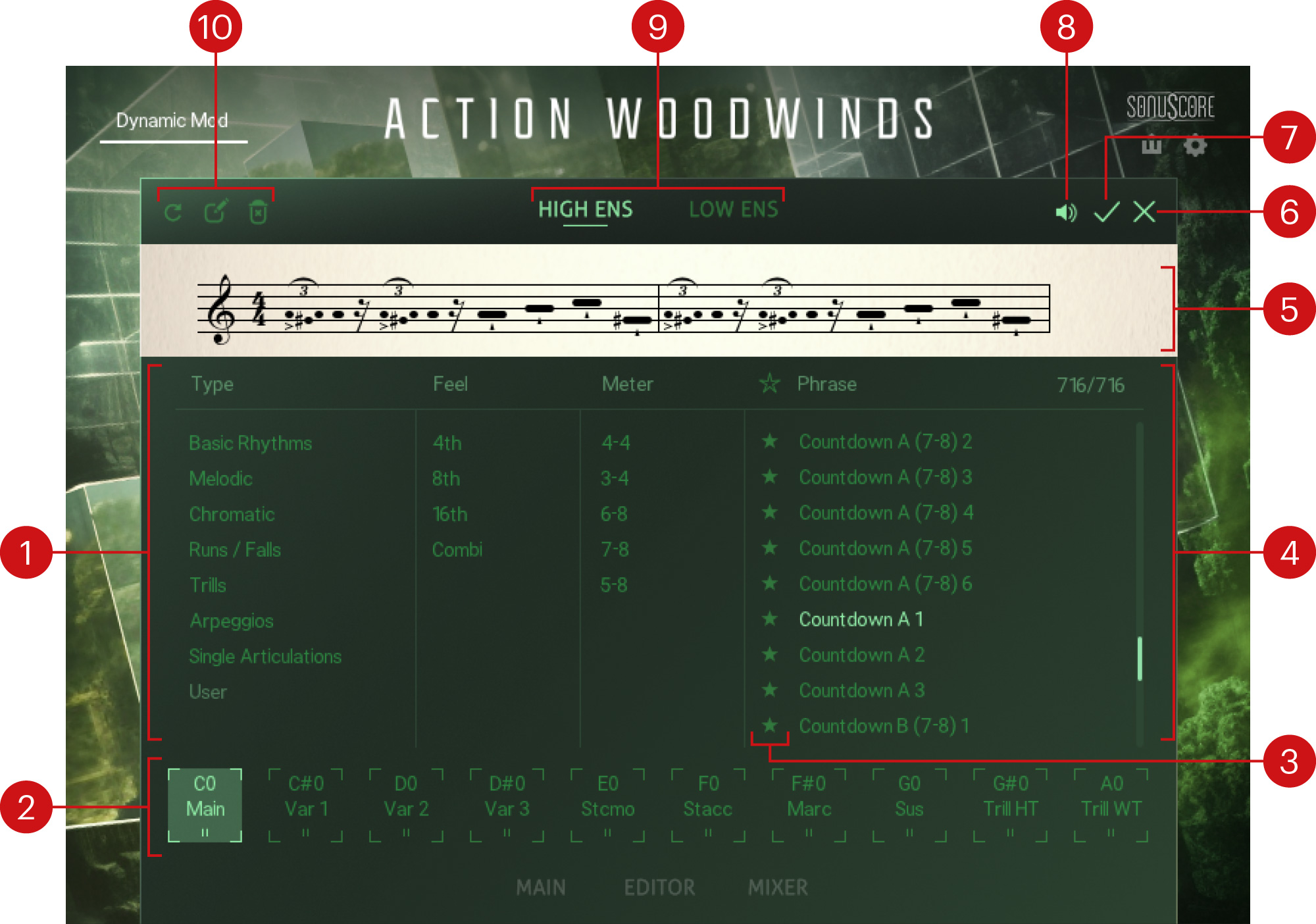
Tag filter: Displays the tags organized in three columns (Type, Feel, Meter). You can select only one tag in each column simultaneously. For more information, refer to Phrase Browser tags.
Keyswitches: The selected keyswitch will host the Phrase that you load. You can click various keyswitches to load multiple Phrases into them. For more information, refer to Keyswitches.
Favorites: You can click the star icons to add or remove Phrases to/from your Favorites. The star icons are lit for Phrases set as Favorites. This way, you can quickly create a custom collection of your most beloved Phrases. You can then display only your favorite Phrases by clicking the topmost star icon next to the Phrase list header. Click the topmost star icon again to display also non-favorite Phrases.
Phrase list: Shows the Phrases matching the tags selected in the Tag filter on the left. You can click a Phrase to load it and try it directly on your keyboard or in your DAW. You can double-click a Phrase to load it onto the selected keyswitch and close the Browser.
Phrase display: Represents the Phrase selected in the Phrase list. The Phrase display can help you visually recognize particular Phrases when switching between entries from the Phrase list.
Cancel (cross icon): Closes the Phrase Browser without changing anything. Your Kontakt Instrument returns to its previous state.
OK (check mark icon): Keeps the selected Phrase loaded and closes the Phrase Browser. This is the same as double-clicking the Phrase in the Phrase list.
Preview (loudspeaker icon): Switches the Preview function on or off. If Preview is on, when you click a Phrase in the Phrase list you can hear it in action.
Ensemble selector: By clicking LOW ENS or HIGH ENS you will browse Phrases for the Low Ensemble or the High Ensemble, respectively. The selected Ensemble is highlighted.
User Phrase tools: Provide controls for importing, editing, and deleting User Phrases. For more information, refer to User Phrases.
Phrase Browser tags
To simplify your search for Phrases, the tags are organized into three columns. Only one tag in each column can be selected simultaneously.
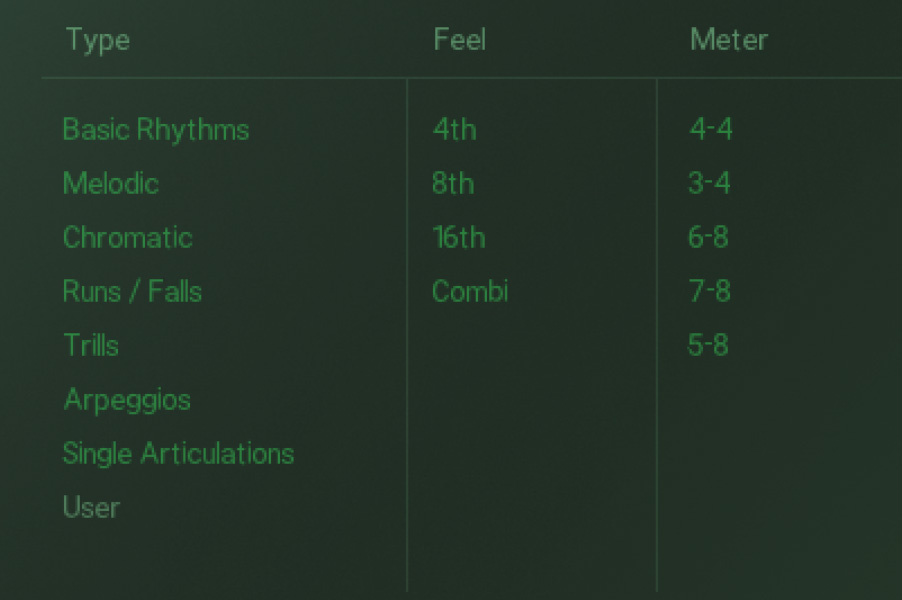 |
The tags in the Phrase Browser
Type: In general, Phrases in Action Woodwinds fall under eight different types, applicable in different compositional scenarios. These include:
Basic Rhythms: Single Pitch Phrases playing rhythmic patterns. Optimized for playing chords.
Melodic: Melodic Phrases with a tonal center. Optimized for generating melodies out of a single note.
Chromatic: Melodic Phrases with less strict tonality. Can be used for playing both single notes and chords.
Runs / Falls: Major or minor, ascending and descending.
Trills: Phrases with rapid alternation between two adjacent notes, usually a semitone or tone apart.
Arpeggios: Phrases based on an arpeggiator. Optimized for playing chords.
Single Articulations: Special Phrases containing a single-note Articulation that can be played freely. For more information, refer to Single Articulations.
User: Custom Phrases saved by you or other users. For more information, refer to User Phrases.
Feel: Allows for searching Phrases with a quarter, eighth, or sixteenth note focus.
Meter: Filters the Phrases according to their time signature.
User Phrases
User Phrases are custom Phrases that you or other users have created. Each User Phrases is accessible as a single file, making it easy to transfer and share between multiple systems.
You can save User Phrases in the Editor page. Once saved, you can organize them using the User Phrase tools in the Phrase Browser.
Note
In the Phrase Browser, the User tag in the Type column is automatically assigned to all User Phrases. You can select this tag to show only User Phrases in the Phrase list.
User Phrase tools
To manage your User Phrases, the Phrase Browser provides the following tools:
 |
Scan (cycling arrow icon): Imports User Phrases. For more information, refer to Importing User Phrases.
Edit (pencil icon): Lets you rename your User Phrase and modify its tags. For more information, refer to Editing a User Phrase.
Delete (trash bin icon): Removes the User Phrase from the Phrase Browser.
Note
A User Phrase that has been removed from the Phrase Browser using the Delete button (trash bin icon) will not automatically reappear upon the next import using the Scan button (cycling arrow icon). To make it appear again in the Phrase Browser, press [option] (Mac) / [Alt] (Windows) + click the Scan button.
You can create User Phrases in the Editor page. For more information, refer to Saving a User Phrase.
Saving a User Phrase
To save a User Phrase:
Click the Save button (disk icon) in the top left corner of the Editor page.
Enter a new name.
Click the check mark to save the User Phrase, or click the cross to cancel the process.

When you click the check mark, the User Phrase is saved and becomes available in the Phrase Browser.
User Phrases are saved as single .nka files into the User Data/Phrases folder under the Action Woodwinds installation directory.
Note
The Action Woodwinds installation directory is located in the content folder defined in Native Access (Preferences panel > File Management page > Content Location field).
Editing a User Phrase
You can modify the name and the tags of an existing User Phrase as follows:
Open the Phrase Browser.
Select the desired User Phrase in the Phrase list.
Click the Edit button (pencil icon) at the top left of the Phrase Browser.
Modify the Phrase name and/or select different tags.
Click the check mark to save your changes, or click the cross to cancel the process.
Note
The tag in the Type column cannot be modified: The User tag is automatically assigned to all User Phrases.
Importing User Phrases
To import User Phrases:
Copy the .nka files of your choice into the
User Data/Phrasesfolder under the Action Woodwinds installation directory.Note
The Action Woodwinds installation directory is located in the content folder defined in Native Access (Preferences panel > File Management page > Content Location field).
Open the Phrase Browser.
Press the Scan button (cycling arrow icon) in the top left corner.
The new User Phrases are imported from the
User Datafolder.
Caution
Make sure to copy the .nka files in the User Data/Phrases folder before you open the Action Woodwinds instrument, otherwise, Kontakt may not recognize all files.
Caution
Do not delete the --START--.nka file from the User Data/Phrases folder, otherwise your User Phrases may not be properly recognized.
Keyswitches
Keyswitches enable you to make quick Phrase or Articulation changes. They are available on your MIDI keyboard as well as in the user interface at the bottom the Main page, the Editor page, and the Phrase Browser.

Keyswitches on the Main page
Each keyswitch shows its key name C0–A0 followed by a term describing the kind of Phrases it activates:
Type | Term | Function |
|---|---|---|
Main | Main | Keyswitch for the main Phrase pair of the Theme (on C0) |
Variations | Var 1–9 | Keyswitch for a variation of the main Phrase pair |
Single Articulations | Stacc, Sus, Stcmo, Trill HT, Trill WT, Marc | Keyswitch for a specific Single Articulation, either for both Ensembles or one, leaving the other Ensemble empty |
Empty | - | Empty keyswitch |
Changing keyswitches
You can change a keyswitch by selecting it and choosing a different Phrase in the Phrase Browser or modifying its Phrase in the Editor page. You can also rearrange your keyswitches by dragging them to the left or right. When you save a User Theme, the keyswitch configuration will be saved alongside the individual Phrase combinations.
Playing with keyswitches
To use a keyswitch and change the Phrase or Articulation, simply trigger the keyswitch before playing the note you want to be affected. Keyswitches can be triggered by pressing the keyswitch (e.g. C0) on your keyboard, entering the key in your DAW, or simply selecting the corresponding keyswitch slot within Action Woodwinds.
If you trigger a keyswitch during a running Phrase, it will be switched instantly, keeping the pulse going. Single Articulations need to be triggered again, as they don’t provide a repetitive rhythm on a single pressed key.
Within the Themes provided in Action Woodwinds, the keyswitches behave mostly as follows:
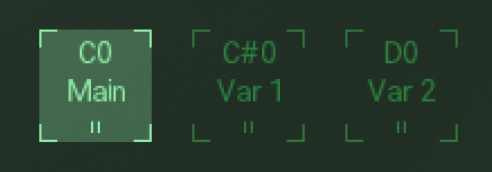 |
C0 is the main version of the Theme.
C♯0, D0, and D♯0 are often tonal variations of the main version.
The following keyswitches are usually Single Articulations to play harmonies freely.
Single Articulations
In addition to the Phrases built from recorded Modules and individual notes, Action Woodwinds also offers individual Single Articulations that can be played freely. They are recorded during the same sessions as the Modules, allowing you to switch seamlessly between Phrases and Single Articulations without significant differences in the sound character.
By default, every Theme contains five keyswitch slots for Single Articulations, but they can also be loaded into Phrase Slots on the Main page by selecting the Single Articulations type in the Phrase Browser. This allows you to combine Phrases and Single Articulations on one keyswitch, or combine different Single Articulations between the two Ensembles.
The following Single Articulations are available:
Staccato
Staccatissimo
Marcato
Sustain
Half-tone Trills (HT)
Whole-tone Trills (WT)
Dynamics for Staccato, Staccatissimo, and Marcato are controlled by note velocity, while Sustain, Tremolo, and Trills are controlled by the specified Dynamic Mod control. To improve the overall playability and sound within the Themes, the Single Articulations for the Low Ensemble are automatically transposed by one octave.
As Single Articulations do not make use of any sequencing features, the Editor page only contains one control for them, the 8va button:
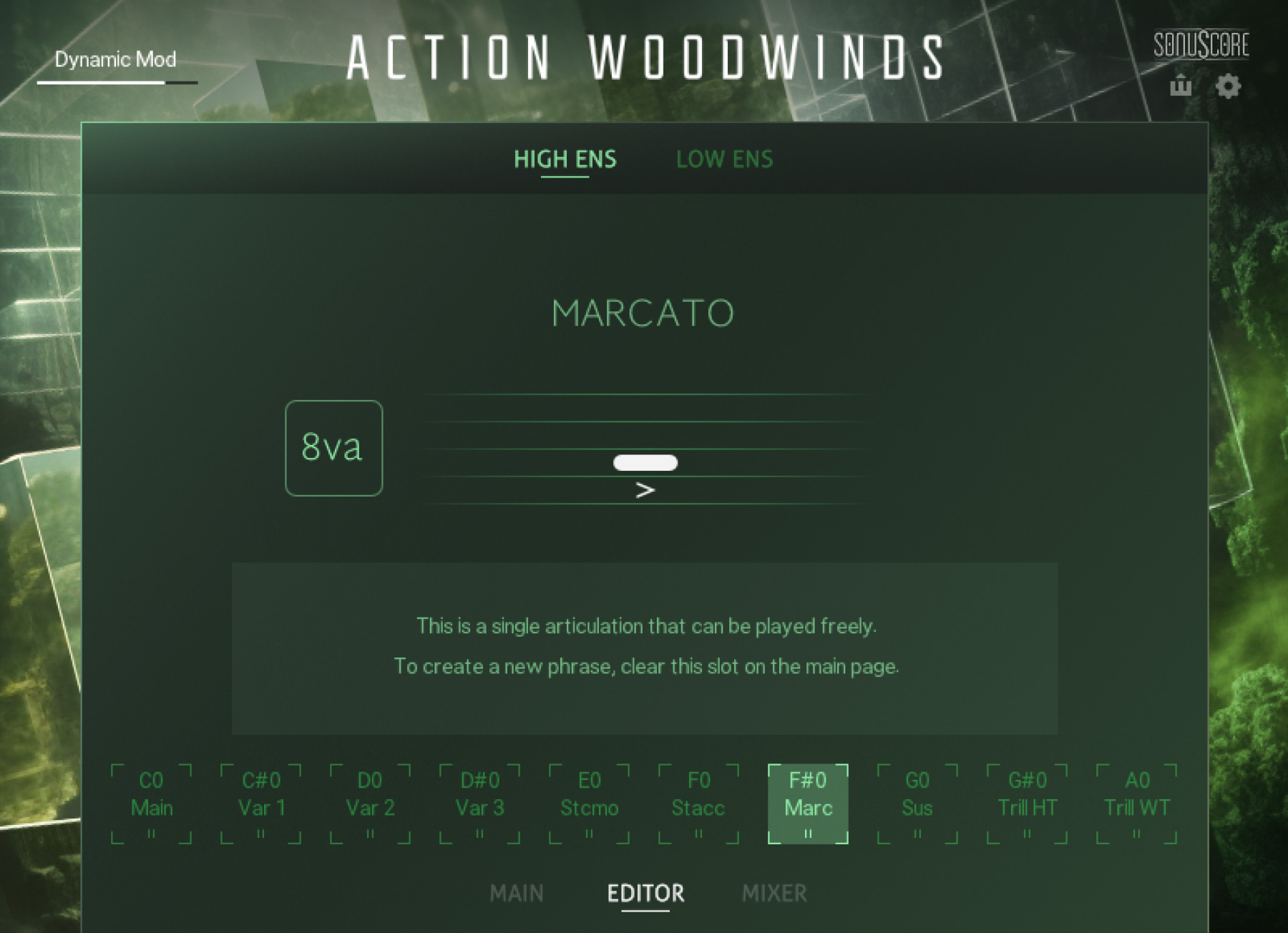
The Marcato Single Articulation in the Editor page
8va: Activates or deactivates the Octaver. When the Octaver is active, all notes played by the Ensemble are doubled an octave higher.
Note
If a Single Articulation is loaded and you want to access the default Editor page, you first need to clear the Phrase Slot on the Main page to create a new empty Phrase with access to the default Editor page.